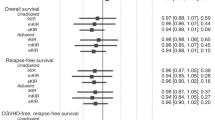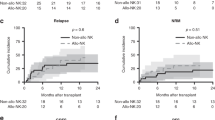Abstract
Natural killer (NK) cell licensing status depends on clonal expression of inhibitory killer cell immunoglobulin-like receptors (iKIR) and short term HLA environment. Licensed NK cells are more efficient in tumor killing than unlicensed NK cells. Cognate KIR–HLA pairs in hematopoietic stem cell transplant (HSCT) donor and recipient are decisive for the possible change in the NK cell licensing status after HSCT. We assessed clinical outcomes in 297 patients with lymphoproliferative or myeloproliferative malignancies, or myelodysplastic syndrome in a model with upward licensing, downward resetting, and unchanged licensing genetics status after T cell replate HSCT from unrelated donors. We found extremely low (0%) relapse/progression incidence (RI), and better (59%) event-free survival (EFS) in recipients with upward licensing status and highly increased RI (37.5%), and reduced EFS (8%) among patients with the downward resetting status of repopulated donor NK cells after HSCT, as compared with unchanged NK cell licensing (RI 23%, EFS 47%). These trends were confirmed in adjusted multivariable models (for RI p = 6.66E−09, OR = 1.47, 95% CI 1.29–1.66 and for EFS p = 3.79E−13, OR = 1.67, 95% CI 1.50–1.84). Differences in the incidence of acute graft versus host disease (GvHD 62, 69, and 47%) and chronic GvHD (24, 44, and 15%, respectively) in three groups were insignificant. It would be rationale the preferential selection of the donors with upward licensing over downward resetting inhibitory KIR:HLA constellation and inclusion of the KIR genotyping in the donor selection algorithm for malignant patients. Further studies using enlarged cohorts of patients with more homogenous diagnosis are essential to reliably verify these preliminary data.


Similar content being viewed by others
References
Anfossi N, André P, Guia S et al (2006) Human NK cell education by inhibitory receptors for MHC class I. Immunity 25:331–342
Brunstein CG, Wagner JE, Weisdorf DJ et al (2009) Negative effect of KIR alloreactivity in recipients of umbilical cord blood transplant depends on transplantation conditioning intensity. Blood 113:5628–5634
Davies SM, Ruggieri L, DeFor T et al (2002) Evaluation of KIR ligand incompatibility in mismatched unrelated donor hematopoietic transplants. Killer immunoglobulin-like receptor. Blood 100:3825–3827
Dorak MT (2014) Major histocompatibility complex, http://www.dorak.info.hla. Accessed 21 Jan 2014
Elliott JM, Wahle JA, Yokoyama WM (2010) MHC class I-deficient natural killer cells acquire a licensed phenotype after transfer into an MHC class I-sufficient environment. J Exp Med 207:2073–2079
Farag SS, Fehniger TA, Ruggeri L et al (2002) Natural killer cell receptors: new biology and insights into the graft-versus-leukemia effect. Blood 100:1935–1947
Foley BA, De Santis D, Van Beelen E et al (2008) The reactivity of Bw4+HLA-B and HLA-A alleles with KIR3DL1: implications for patient and donor suitability for haploidentical stem cell transplantations. Blood 112:435–443
Giebel S, Locatelli F, Lamparelli T et al (2003) Survival advantage with KIR ligand incompatibility in hematopoietic stem cell transplantation from unrelated donors. Blood 102:814–819
Graef T, Moesta AK, Norman PJ et al (2009) KIR2DS4 is a product of gene conversion with KIR3DL2 that introduced specificity for HLA-A*11 while diminishing avidity for HLA-C. J Exp Med 206:2557–2572
Joncker NT, Shifrin N, Delebecque F et al (2010) Mature natural killer cells reset their responsiveness when exposed to an altered MHC environment. J Exp Med 207:2065–2072
Kawase T, Matsuo K, Kashiwase K et al (2009) HLA mismatch combinations associated with decreased risk of relapse: implications for the molecular mechanism. Blood 113:2851–2858
Kim S, Poursine-Laurent J, Truscott SM et al (2005) Licensing of natural killer cells by host major histocompatibility complex class I molecules. Nature 436:709–713
Kim S, Sunwoo JB, Yang L et al (2008) HLA alleles determine differences in human natural killer cell responsiveness and potency. Proc Natl Acad Sci USA 105:3053–3058
Long EO, Rajagopalan S (2000) HLA class I recognition by killer cell Ig-like receptors. Semin Immunol 12:101–108
Long EO, Kim HS, Liu D et al (2013) Controlling natural killer cell responses: integration of signals for activation and inhibition. Annu Rev Immunol 31:227–258
Michaelis SU, Mezger M, Bornhäuser M et al (2014) KIR haplotype B donors but not KIR-ligand mismatch result in a reduced incidence of relapse after haploidentical transplantation using reduced intensity conditioning and CD3/CD19-depleted grafts. Ann Hematol 93:1579–1586
Nowak J, Mika-Witkowska R, Graczyk-Pol E (2012) Genetic methods of HLA typing. In: Witt M, Dawidowska M, Szczepanski T (eds) Molecular aspects of hematologic malignancies. Springer, Berlin, Heidelberg, pp 325–339
Nowak J, Kościńska K, Mika-Witkowska R et al (2014) Donor NK cell licensing in control of malignancy in hematopoietic stem cell transplant recipients. Am J Hematol 89:E176–E183
Nowak J, Kościńska K, Mika-Witkowska R et al (2015) Role of donor activating KIR-HLA ligand-mediated NK cell education status in control of malignancy in hematopoietic cell transplant recipients. Biol Blood Marrow Transplant 21:829–839
Oevermann L, Michaelis SU, Mezger M et al (2014) KIR B haplotype donors confer a reduced risk for relapse after haploidentical transplantation in children with ALL. Blood 124:2744–2747
Orr MT, Lanier LL (2010) Natural killer cell education and tolerance. Cell 142:847–856
Re F, Staudacher C, Zamai L, Vecchio V, Bregni M (2006) Killer cell Ig-like receptors ligand-mismatched, alloreactive natural killer cells lyse primary solid tumors. Cancer 107:640–648
Robinson J, Halliwell JA, McWilliam H et al (2013) The IMGT/HLA database. Nucleic Acids Res 41:D1222–D1227
Ruggeri L, Capanni M, Urbani E et al (2002) Effectiveness of donor natural killer cell alloreactivity in mismatched hematopoietic transplants. Science 295:2097–2100
Ruggeri L, Mancusi A, Capanni M et al (2007) Donor natural killer cell allorecognition of missing self in haploidentical hematopoietic transplantation for acute myeloid leukemia: challenging its predictive value. Blood 110:433–440
Scrucca L, Santucci A, Aversa F (2007) Competing risk analysis using R: an easy guide for clinicians. Bone Marrow Transplant 40:381–387
Zhao XY, Chang YJ, Zhao XS et al (2015) Recipient expression of ligands for donor inhibitory KIRs enhances NK-cell function to control leukemic relapse after haploidentical transplantation. Eur J Immunol 45:2396–2408
Acknowledgements
The authors would like to thank the following members of Polish Donor–Recipient Matching Study Group who have provided clinical data: Monika Mordak-Domagała and Janusz Lange, from Lower Silesian Center for Cellular Transplantation with National Bone Marrow Donor Registry, Wroclaw, Jacek Wachowiak and Małgorzata Barańska from Department of Oncology Hematology and Pediatrics Transplantology, Poznan Medical University, Poznan, Mieczysław Komarnicki, Lidia Gil and Anna Czyż from Department of Hematology and Bone Marrow Transplantation, Poznan Medical University, Poznan, Anna Gronkowska and Wiesław Wiktor Jędrzejczak from Department of Hematology, Oncology and Internal Medicine, Medical University of Warsaw, Warsaw, Sławomira Kyrcz-Krzemień, Mirosław Markiewicz, Monika Dzierżak-Mietła from Department of Hematology and Bone Marrow Transplantation, Silesian Medical University, Katowice, Andrzej Hellmann and Maria Bieniaszewska from Department of Hematology and Transplantology, Medical University of Gdansk, Jerzy Kowalczyk and Katarzyna Drabko from Department of Pediatric Hematology, Oncology and Transplantology, Medical University, Lublin, Jolanta Goździk from Transplantation Centre, University Children’s Hospital, Medical College, Jagiellonian University, Cracow, Kazimierz Hałaburda, Agnieszka Tomaszewska, Barbara Nasiłowska and Andrzej Szczepiński from Department of Hematopoietic Stem Cell Transplantation, Institute of Hematology and Transfusion Medicine, Warsaw, Poland. This study was supported by Grants from the National Center of Science (N N402 351138) and the National Centre for Research and Development (N R13 0082 06).
Author information
Authors and Affiliations
Corresponding author
Ethics declarations
Conflict of interest
The authors declare no conflict of interest in connection with the authorship.
Electronic supplementary material
Below is the link to the electronic supplementary material.
About this article
Cite this article
Rogatko-Koroś, M., Mika-Witkowska, R., Bogunia-Kubik, K. et al. Prediction of NK Cell Licensing Level in Selection of Hematopoietic Stem Cell Donor, Initial Results. Arch. Immunol. Ther. Exp. 64 (Suppl 1), 63–71 (2016). https://doi.org/10.1007/s00005-016-0438-2
Received:
Accepted:
Published:
Issue Date:
DOI: https://doi.org/10.1007/s00005-016-0438-2




